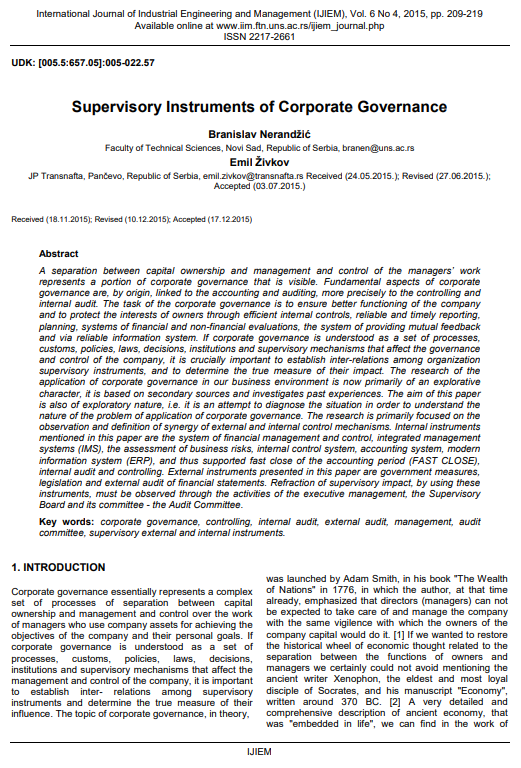
Published 2015-12-30
abstract views: 35 // FULL TEXT ARTICLE (PDF): 0
Keywords
- corporate governance,
- controlling,
- internal audit,
- external audit,
- management
- audit committee,
- supervisory external and internal instruments ...More
How to Cite
Copyright (c) 2023 International Journal of Industrial Engineering and Management

This work is licensed under a Creative Commons Attribution 4.0 International License.
Abstract
A separation between capital ownership and management and control of the managers’ work represents a portion of corporate governance that is visible. Fundamental aspects of corporate governance are, by origin, linked to the accounting and auditing, more precisely to the controlling and internal audit. The task of the corporate governance is to ensure better functioning of the company and to protect the interests of owners through efficient internal controls, reliable and timely reporting, planning, systems of financial and non-financial evaluations, the system of providing mutual feedback and via reliable information system. If corporate governance is understood as a set of processes, customs, policies, laws, decisions, institutions and supervisory mechanisms that affect the governanceand control of the company, it is crucially important to establish inter-relations among organization supervisory instruments, and to determine the true measure of their impact. The research of the application of corporate governance in our business environment is now primarily of an explorative character, it is based on secondary sources and investigates past experiences. The aim of this paper is also of exploratory nature, i.e. it is an attempt to diagnose the situation in order to understand the nature of the problem of application of corporate governance. The research is primarily focused on theobservation and definition of synergy of external and internal control mechanisms. Internal instruments mentioned in this paper are the system of financial management and control, integrated management systems (IMS), the assessment of business risks, internal control system, accounting system, modern information system (ERP), and thus supported fast close of the accounting period (FAST CLOSE), internal audit and controlling. External instruments presented in this paper are government measures, legislation and external audit of financial statements. Refraction of supervisory impact, by using these instruments, must be observed through the activities of the executive management, the Supervisory Board and its committee - the Audit Committee.
Article history: Received (18.11.2015); Revised (10.12.2015); Accepted (17.12.2015)

